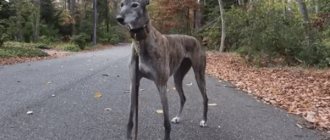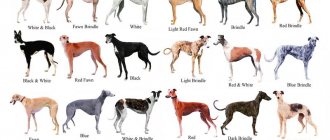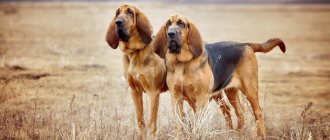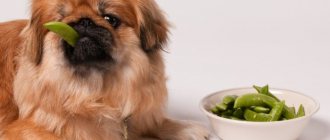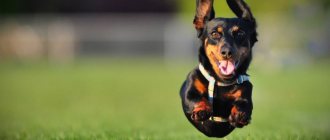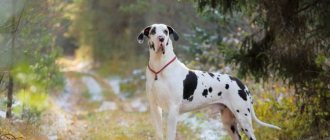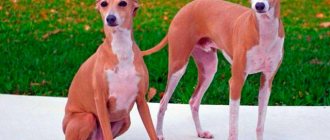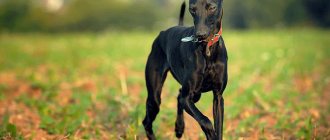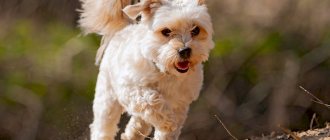An elegant aristocrat - there is no other way to call this sophisticated creature with an intelligent look and long paws. But the Greyhound is valued all over the world not only for its striking appearance and remarkable intelligence. He is recognized as the best runner, as he can run up to 67 kilometers per hour. This quality, plus the excellent skills of a born hunter, together make this breed one of the best hunting hounds.
Description of the Greyhound breed
Popularity 206th place among 263 dog breeds
Lifespan:
9-11 years
Breed group:
Greyhounds
Height:
males: 71-77 cm, females: 68-71 cm
Country of origin:
Great Britain
Average price:
25-35 thousand rubles
Weight:
males: 29-32 kg, females: 27-29 kg
Latest articles Cat health
Rabies vaccination for cats: choice of vaccine, necessity, schedule 01/22/2022 15 0 0
Selection and adaptation
TOP 20 best cat breeds for families with children 01/22/2022 27 0 0
Price
Almost every major city in Russia has kennels where these wonderful dogs are bred. A high-quality representative of the breed is expensive, from 25 to 45 thousand rubles. In Moscow they are sold from 30 thousand rubles.
The price of a greyhound without documents, the origin of which is unknown, is from 5 to 12 thousand rubles. In order not to make a mistake when choosing a dog, we recommend that you study the standard in advance and ask the breeder to show a photo of the puppy’s parents. If, in your opinion, they fully meet the requirements of the standard, you can safely take the dog.
Key facts
Greyhounds are among the fastest dogs in existence today. They are designed for running or hunting field game.
Another name for the four-legged dog is associated with its country of origin - the English greyhound. When literally translated, the name of the breed sounds like a gray greyhound, or a cricket greyhound (griehound).
The description of greyhounds is unusual: despite their passion for hunting and love of running, they are considered large sleepyheads. Dogs can fall asleep instantly, and not even in the most convenient places for this. Dogs show incredible love for their owner and become loyal friends and excellent companions. They know how to show understanding and delicacy in various situations.
In terms of mental indicators and intelligence, greyhounds took 46th place of honor in the list of the most intelligent breeds according to Stanley Coren. The characteristics of the Greyhound breed are always based on these indicators, first of all.
In English greyhounds, conscious age occurs only at 1.5-2 years. Until this time, they show childish spontaneity and are ready to play pranks and play without interruption.
Representatives of the English breed cannot be classified as long-livers. The average lifespan of a Greyhound is only 9-11 years. The weight of the female varies from 27 kg to 29 kg, the male – in the range of 29-32 kg. The height at the withers in females reaches 68-71 cm, in males the height is slightly higher - 71-77 cm.
Persian Greyhound
- Height: from 45.7 to 71.1 cm
- Weight: from 18.2 to 29.5 kg
- Colors: many different colors and patterns
- Life expectancy: 10-17 years
- Health: There are no serious genetic diseases, but the breed may be predisposed to heart disease, certain types of cancer and autoimmune diseases. Owners should be aware of the increased risk of volvulus or gastric bloat
The elegant and independent Persian Greyhound is better known by another name - Saluki . As one of the oldest known dog breeds , the Persian Greyhound dates back to 7000 BC. They were favorites of the Egyptian pharaohs, Alexander the Great and the Ming dynasty. Salukis may look fragile, but they are built to withstand harsh conditions.
Salukis can be reserved around strangers and still retain an independent streak that sets them apart as reliable sighthounds.
IMPORTANT! They love exercise but can get bored easily, so repetitive exercise should be avoided. Gentle training methods such as positive reinforcement are recommended. Salukis rarely enjoy games like fetch, but they can't always resist the temptation to chase fast-moving objects like birds or squirrels!
Saluki is grace combined with strength . They have long narrow heads with floppy, silky ears. Persian Greyhounds have a broad back with a clear arch over the loin, and a deep and narrow chest. Their strong legs allow them to run effectively over long distances over rough terrain. Salukis are very clean and do not have the typical dog smell.
History of the origin of the Greyhound
There are no precisely confirmed historical facts about the past of the gray greyhound. At first, Ancient Egypt was called their homeland, where drawings of similar dogs and their mummified remains were found. But a 2004 genetic study refuted this view. During the analyses, it was found that they have no relationship with Egyptian individuals. It turned out that greyhounds have a lot in common with shepherd dogs. This discovery prompted scientists to think about the ancient Celtic origin of the breed.
In the first half of the 10th century, the so-called Egyptian dogs began to spread in European countries. In Foggy Albion they were used for hunting without a gun. Excellent short-distance runners were able to easily catch a hare or a roe deer. This type of entertainment was preferred by the European nobility, so these swift dogs became the favorites of noble people.
Closer to the 18th century, there was a decline in the popularity of the breed. But the work of the British greyhound breeder Lord Alford bore fruit. He sought to improve the breed, so he diluted the greyhound blood with the blood of the English bulldog. With this Alford wanted to achieve greater endurance in the dogs. In 1776, the first hunting club appeared in England, in which tests of the working qualities of the gray greyhound were carried out.
At the end of the 19th century, interest in greyhound racing grew, in which greyhounds found it difficult to compete. At the same time, three branches of animals were identified: exhibition, racing and hunting. Official world recognition of the breed took place in 1946 after the opening of the first greyhound fan club in Great Britain.
Interesting fact: in 1994, a representative of the English breed named Star Title was noted as the fastest dog in the world in the Guinness Book of Records. His speed at the competition was 67.32 km/h.
The high cost and belonging to elite pets has long prevented dogs from gaining popularity not only in the country of origin, but also beyond its borders. In Russia, individuals of this breed became widespread only after the collapse of the USSR - until that time they were considered a relic of capitalism. Now there are a number of kennels engaged in breeding and popularizing gray greyhounds, but their numbers in our country remain small.
Afghan Hound
- Height: from 63.5 to 68.6 cm
- Weight: 22.7 to 27.3 kg
- Colors: black, black-silver, black-brown, blue, cream, red, silver and white. May have brindle or domino markings
- Life expectancy: 12-15 years
- Health: Generally healthy dogs, but like other greyhounds with low body fat, they can be sensitive to anesthesia. Breeders should pay special attention to the hip joints, eyes and thyroid gland. May suffer from bloating
Some experts claim that the Afghan Hound is the oldest purebred dog in the world; others believe that they represented the kingdom of dogs on Noah's ark. It is believed that this breed predates the advent of writing and has since been a popular attribute of Eastern culture. These dogs are the embodiment of elegance and nobility.
Afghan Hounds may be aloof from strangers, but are happy and playful when they are around their families. Like all greyhounds, they have a strong hunting instinct and may not resist the urge to chase small and fast-moving creatures. Afghan hounds are independent and may not always respond to commands.
Afghan Hounds carry themselves with dignity and grace with their proud stance, high hips and distinctive curled “ring” at the end of their tail. Their distinctive feature is a long, thick coat consisting of fine and silky hair. The fur along the back is short, all other parts of the body are covered with long hair.
Greyhound appearance
General impression
Breeding of the breed is carried out along three lines:
- the show class is represented by beautiful individuals with a height at the withers of at least 77 cm, intended for participation in exhibitions and shows;
- racing dogs, which are athletes from birth and have strong muscles;
- hunters for whom performance is valued more than appearance.
It is not recommended to mix animals of different branches, so as not to lose their innate qualities.
In general, greyhounds combine natural stature, an elegant figure and necessarily long legs. The photo of a greyhound clearly shows how the muscles are stretched along the body, so the silhouette looks sophisticated.
Head
The dog's moderately long and wide head has a flat skull. An elongated, lean muzzle should look textured. The English Greyhound's jaws form massive scissors when connected, with the upper incisors covering the outside of the lower teeth.
The slightly slanted eyes of the Greyhound are oval in shape. In a healthy pet they are dark in color and shiny. With light colors, a not too dark shade of the iris is possible. The ears are thin, neat, protrude back, but rise when alert.
Neck
Like the rest of the Gray Greyhound's body, it should be muscular and elongated, with an elegant transition to the withers. There are no skin folds, wrinkles or dewlap on the neck.
Torso
It looks quite stretched due to the longitudinal muscles and is very powerful, but not stocky. The dog's chest is deep, with a relief transition to the stomach and convex ribs. The back has a massive lower back and muscles of increased density.
Forelegs
The front legs of the individual are distinguished by well-developed muscles and dry outlines. The shoulder blades are inclined, the elbows are freely located under them. The pasterns are round in shape with tight pads.
Hind limbs
Designed for powerful pushing, the hind legs have strong shins and thighs. The wide hock joints are set fairly low. The knees are clearly visible. Pets have strongly arched fingers and dense nails that require regular care.
Tail
The Greyhound's tail is thick at the base and tapers towards the tip. It is low-slung and is considered a rudder when the dog is moving. A slight bend starts from the middle in any position of the animal.
Movement
The English greyhound moves with sweeping movements. This allows her to accelerate quickly. The tremors are quite strong, but still inferior to some other trotting breeds.
Wool
The coat fits tightly to the animal's body. The hair is smooth to the touch, with a dense structure. There is little undercoat on the entire body. The coat is less dense on the belly and inner thighs.
Color
There are individuals of different colors: red, black, white, brindle and fawn. Sometimes the colors are diluted with white spots. This is not prohibited by the breed standard.
Size
The size of the greyhound, despite its grace, is impressive. These are quite tall dogs, for example, the height of a male greyhound reaches 77 cm, and that of a female - 71 cm. The weight of greyhounds depends on gender: in females it reaches 27-29 kg, males weigh a little more - 29-32 kg.
Distinctive features
A breed standard is a guideline that describes the ideal characteristics, temperament and appearance of a dog, including the correct coloring. This is necessary for breeders who want to preserve its purity so that the dog matches its breed.
The main features of dogs of this breed are::
- The body is powerfully built, muscular, hardy and resilient.
- The head is long, with an almost imperceptible transition from the muzzle to the forehead.
- The neck is elongated, elegantly curved, blending smoothly into the shoulders.
- The shoulders are perfectly formed.
- The eyes are darkish, oval-shaped, expressive and shiny.
- The ears are not wide. They have a petal shape with small hair.
- The paws are small, with dense pads and toes pulled together into a ball.
- The tail is low, goes under the dog, long, tapering towards the end.
- Body with a recessed chest housing internal organs. The ribs are elongated and directed backwards.
Greyhound character
Representatives of the English breed combine the characteristics of a tireless athlete and an imposing couch potato. At home, a dog can spend the whole day half asleep on a rug or in a bed. But once prey appears on the horizon, the greyhound will be unstoppable.
Dogs are herd animals and are very dependent on the group. They consider the owner's family and other gray greyhounds living in the neighborhood to be a pack. However, there should be only one leader: the rest are obliged to obey him. If the pet lives with people, then the owner of the dog becomes the leader. If living with other greyhounds, the leader is chosen through psychological pressure and even fights.
Greyhounds treat children calmly, without irritation, but will not take part in games. But they have boundless love for their adult owner. Licking his face and throwing himself on his neck when he meets him is the dog’s household duty.
Greyhounds are able to live peacefully with other animals, but if they treat a domestic cat calmly, then the yard cat will become an object of hunting. Four-legged dogs can also confuse decorative dogs with game, so when walking on the street you should use a leash so as not to lose your pet or get into trouble.
Greyhounds have low guarding qualities, so they are not used as watchdogs. They treat strangers favorably and are ready to endure their stroking and attention in order to please the owner. In general, the Greyhound's character can be called more friendly than withdrawn.
Arabian greyhound
- Height: from 61 to 73.7 cm
- Weight: from 20.4 to 31.8 kg
- Colors: cream, mahogany, red or sand. May have brindle markings or black masks
- Life expectancy: 12-14 years
- Health: generally very good. Breeders will screen for progressive retinal atrophy and certain autoimmune diseases. The Arabian Greyhound is also sensitive to anesthesia, vaccines and deworming medications.
The now rare Arabian Greyhound is another ancient sighthound species, also known as the Slugi . These dogs were originally bred by the Bedouins and Berbers of North Africa. It is believed that they may have been introduced to Europe when Hannibal made his infamous crossing of the Alps.
These African dogs are gentle with their owners, but reserved with strangers. They can be described as aloof and dignified, and do not always appreciate overly dramatic displays of affection from people they do not know or trust. They need plenty of exercise every day , including the opportunity to run freely and quickly without a leash. Their sensitive nature means that gentle teaching methods are an absolute necessity.
Slugs are medium to large sized dogs with a robust yet elegant appearance. Their head is long and graceful, with medium-sized ears; They have a deep chest with a well-tucked belly, and the line of the back is mostly horizontal, merging into a sloping croup.
Education and training
English greyhounds are considered to be animals that are very difficult to train. Indeed, it is quite difficult to accustom them to commands due to their habit of being independent during hunting. Greyhounds are very artistic and love to show it off in the ring.
Education and training begin upon reaching adulthood. There is no point in training puppies, because at this time they are practically uncontrollable, and nothing can be done about it. You will have to be patient and wait for the pet to grow up.
Experienced dog trainers advise starting training no earlier than 1 year. But by this age the baby must:
- understand the owner’s prohibitions;
- respond to the nickname the first time;
- be able to walk on a leash.
English greyhounds are happy to train if they feel excitement and interest in what is happening. When they are bored, they will not do anything. Food is also not a basis for them to fulfill the commands and demands of the owner. Greyhounds should be encouraged by showing attention and wanting to spend time with him.
Due to the nature of the fidget, it is difficult to carry out commands that require waiting. They always want to run somewhere and play pranks. However, the commands “Sit!”, “Wait!” a trained animal must be one of the first to master.
Puppies of the sporting branch begin to be trained at 2-3 months. They are chased after a toy, then taught to run distances of no more than 100 meters after the bait. Gradually the distance increases. You can train your pet by tying it to a bicycle using a special leash. Overload, especially at a young age, can have a bad effect on your health and even lead to heart problems.
Honing hunting skills begins with accustoming to smells. To do this, 2-3 month old babies are brought to the field and allowed to walk around on a leash, sniffing at what surrounds them. At six months the animal is trained to bring prey using a special toy.
It is important for exhibition animals to have the correct exterior. You will have to carefully care for the dog’s appearance and teach it to walk in the ring. To begin with, use a muzzle, gradually you need to abandon it.
Looking for a Greyhound? Find your pet from 1 offer As a gift
Hare hunting
Greyhounds begin to prepare for hunting at three months of age. At this time, the puppy is just getting acquainted with the prey. For this purpose, a live hare is tied up and shown to the puppy. It is important to stay close to your pet, since a hare is a wild animal that can bite a baby, leaving him with psychological trauma in the form of fear of hunting. To awaken the dog's hunting instinct, it is necessary to hold the hare in front of the puppy. After the baby grabs the prey, praise and repeat. It is advisable to train several puppies at once to develop the spirit of competition.
The next stage begins at the age of six months. A teenager is taken hunting with other dogs. At this stage, the dog gets used to the car and watches the adults hunt.
At eight months of age, the greyhound should periodically receive baited prey to play with in order to get used to holding it in its teeth. At this time, it is important to teach how to give up the prey; to do this, after she has patted the hare a little, you need to lightly hit her on the head and then reward her. It is strictly not recommended to give the entrails or meat of the prey to eat, otherwise the pet will kill and tear the hare on the spot or, on the contrary, run away from the owner with it.
Greyhounds are fed five hours before hunting, otherwise they will be clumsy. In addition, a well-fed dog running at high speed runs the risk of intestinal volvulus. If the hunt goes on for a long time, it is necessary to water the dog; you can feed it only upon return.
Greyhound Health and Disease
Possible diseases
Greyhounds are not prone to frequent illness and rarely have genetic problems. Due to physiological characteristics, the animal needs soft and warm bedding, as it is afraid of drafts. Because of this, frequent colds are possible.
Osteosarcoma is considered the most dangerous disease in dogs. This is a bone cancer that often cannot be cured. The first symptom is the pet's lameness.
Eye diseases of greyhounds, in addition to inflammation and conjunctivitis, include pannus. This is a hereditary disease that appears between the ages of 2 and 5 years. It is characterized by clouding of the lens of the eye. There is only symptomatic treatment; it is impossible to completely get rid of the problem. When left untreated, pannus leads to blindness.
Thyroid gland dysfunction leads to hypothyroidism. Its result is infertility, slowness, and deterioration of the animal's coat.
Typical diseases of greyhounds include:
· age-related joint problems;
· deafness;
· skin and food allergies;
· pneumonia.
If you discover problems in your pet's health, you should immediately contact a veterinarian. Regular antiparasitic treatments for your pet should not be neglected. Routine vaccination against rabies, distemper, enteritis, viral hepatitis, and leptospirosis will help maintain a quality life.
The first vaccinations are given at 2 months, and after 3 weeks they are repeated. At six months they give an injection against rabies and carry out a third comprehensive vaccination. From the age of one year and annually they are vaccinated against a set of viral diseases.
Reproductive health
Female English greyhounds become sexually mature at 1.5-2 years of age. The body of a dog of this age is ready for mating and the birth of healthy offspring. Usually mating occurs 10-15 days after the start of estrus. Bitches can be spayed after their third estrus.
It is better to carry out mating in the male dog’s territory. It is important to be patient because dogs are quite shy and take time to get used to.
Italian Greyhound
- Height: from 33 to 38 cm
- Weight: from 3.2 to 6.4 kg
- Colors: almost all colors, including those with white markings
- Life expectancy: 14-15 years
- Health: Generally good, but breeders should screen for Legg-Calvé-Perthes disease, hypothyroidism, autoimmune diseases and progressive retinal atrophy (PRA)
If you want a miniature Greyhound, the Italian Greyhound is the one for you! The breed is believed to have originated from the Roman Empire, and they have been valued as noble companions for at least 2,000 years. Known as a status symbol during the Italian Renaissance, this smallest greyhound
Sensitive and intelligent Italian greyhounds simply adore their owners. They are alert, playful and energetic, but they also like to curl up waiting for their owners to be free - but don't be surprised if they try to sit on your lap!
These Italian dogs are sensitive but also a little stubborn, so positive reinforcement methods work best.
The Italian Greyhound is very similar to its larger cousin, the Greyhound, but has a slightly slimmer build with elegant and graceful lines, with a deep, narrow chest. Her skin is beautiful and her hair is soft and shiny, almost satiny. From the middle of the back, a curve begins, descending to the hind limbs. Italian Greyhounds have long and muscular limbs, but are very slender.
Features of feeding and diet
Despite their apparent thinness, Greyhounds love to eat and will not be capricious when choosing tasty morsels. The dog will happily accept any food from the owner's hands. However, the diet should be high in calories; the diet should be based on lean meat. Offal and low-bone fish make good additions. Care must be taken with wild-caught game. Giving your dog wild meat is only possible after veterinary control, otherwise dangerous parasites can harm the pet’s health.
Up to 6 months, the puppy needs to be fed at least 5-6 times a day. Food should be rich in healthy vitamins and minerals. The basis of the diet is low-calorie fermented milk products, low-fat cottage cheese, boiled chicken egg yolk mixed with dairy products. After one month of age, it is useful to give cartilage and non-tubular bones to strengthen the baby’s teeth and jaw.
The proportion of porridge should not exceed a quarter of the adult dog’s feeding norm. Rolled oats, buckwheat and rice cereals are recommended. It is useful to add raw, grated vegetables and fruits to food. Consuming fish oil or vegetable oils for your pet will have a good effect on the appearance of the coat.
The owner decides what to feed the greyhound, but some breeders prefer to combine natural and dry food. By doing this, they solve the problem of enriching the diet with vitamin and mineral complexes. Dry food must be used at least premium class - only in this case it will not cause harm to health. We must not forget about clean fresh water, which should always be present in your pet’s bowl.
The following are strictly contraindicated for dogs:
- salty and spicy foods;
- chocolate and sweets;
- flour;
- fat;
- tubular, as well as small sharp bones.
You shouldn’t pamper your pet with food from the owner’s table, no matter how hungry his eyes look. Such tasty pieces will have a bad effect on the gastrointestinal tract and can lead to food allergies.
Whippet
- Height: from 45.7 to 55.9 cm
- Weight: from 11.4 to 18.2 kg
- Colors: Almost all colors, including those with white markings or dark masks on the face
- Life expectancy: 12-15 years
- Health: Generally good, but breeders should screen puppies for heart disease, deafness, and visual impairment
The graceful whippet was bred as a smaller version of the greyhound, cheaper and easier to keep. Revered by miners in the north of England, they were nicknamed "poor man's racehorses" due to the popularity of racing involving these lightning-fast dogs. Whippets were first registered by kennel clubs in 1888 and have been very popular ever since.
In the house and on a leash, whippets are calm and even-tempered, but let them run (in a fenced area!) and you'll soon see how fast they are! Whippets are affectionate and loving animals that can live happily in an apartment if they are walked regularly. They do have a mischievous streak , so training is necessary so that you can channel their energy into productive channels.
Whippets are very similar to Greyhounds, only slightly smaller in size. Their bodies have the characteristic inverted s-shape of greyhounds. They have strong but thin legs, deep chests and very thin waists. Whippets have a long and elegant arched neck. Their ears are small, folded when the whippets are alert, and folded along the neck when the whippets are at rest.
Care and maintenance
The thin undercoat forces the Greyhound to seek shade in summer and warmth in winter. The dog should be kept in a heated room during the cold season, but when the air temperature rises, it will be comfortable in the enclosure. If it is not possible to keep and care for a greyhound at home, then it is necessary to equip a warm outdoor enclosure with high wooden floors.
An animal can comfortably stay in a city apartment, as it does not require much space and does not get underfoot. You should walk your dog on a leash in urban areas so that it is not tempted to chase another animal. Two walks a day for 1-2 hours will be enough for the Greyhound: he will happily spend the rest of the time half asleep. A warm overall or raincoat will help your pet not get wet and avoid hypothermia.
The English Greyhound requires basic care. Pets should be periodically combed using a special rubber mitten. Washing is necessary only in case of severe contamination; otherwise, the dog is wiped first with a damp and then with a dry towel. It is unlikely that you will have to do this often, because the dog has innate cleanliness. The individual sheds slightly, and in females shedding occurs more often: during estrus and after birth.
More attention should be paid to the claws of the English greyhound. Overgrown claws deform limbs, interfere with running, and lead to injuries. You need to cut your nails 2 times a week, using a nail clipper and a nail file to smooth out any uneven areas.
Systematically clean the ears and teeth of pets, wipe the gas. These procedures are carried out using special products: a toothbrush for dogs, veterinary paste, lotion for eye and ear care. You can try replacing the lotion with chamomile infusion or boiled water, and replacing dog toothpaste with baking soda.
The dogs' paws are washed and examined after each walk. If cracks or wounds are found, they are treated with an antiseptic. After walks in nature, it is mandatory to check for ticks. If you find any, contact your veterinarian immediately. Delay can be fatal.
Russian greyhound
- Height: more than 66 cm
- Weight: from 34 to 47.6 kg
- Colors: almost any color, including brindle and ticked shades
- Life expectancy: 9-14 years
- Health: Generally healthy breed. Breeders should check for elbow and hip dysplasia, eye and heart disease. May suffer from bloating. More sensitive to anesthesia than other greyhound breeds
The Russian Greyhound or Russian Wolfhound is better known as the Russian Greyhound. The name of the breed comes from the Russian word "borzoi", which means "fast", which these dogs certainly are! They have existed since the 16th century. These independent dogs love to run and need a safe, enclosed space within which they can run at their best.
Russian Greyhounds are very sensitive and do best with experienced and compassionate owners . They are attached to their families, but they do not like intrusion into their personal space.
IMPORTANT! As is the case with many other greyhound breeds, Russian Greyhounds can be selective in the commands they are willing to obey. This may be misinterpreted as disobedience, but in reality it is just a manifestation of the independent spirit of Russian greyhounds!
This Russian dog breed is elegant and agile, with a classic, slightly arched back. She has a narrow but very deep chest, contrasting with a toned but muscular lower back. The coat is long and silky and can be smooth or slightly wavy.
Tips for choosing a puppy
When purchasing a Greyhound puppy, start by finding a good kennel. In this case, it would be a good idea to read reviews on numerous forums on the Internet. You can invite an experienced owner of this breed or a dog handler to meet your baby for the first time, who will help you make the right choice.
Take an interest in the achievements of the puppy's parents. As a rule, inheritance of the talents of ancestors occurs at the genetic level. You should look for a racing dog at film shows, a puppy for showing - at specialized exhibitions, but a future hunter will appear only with parents working in the field. Greyhound puppies for home keeping do not require such close attention to pedigree.
The price for a puppy will depend on its pedigree, line standards, exterior and popularity of the kennel.
How to choose a pet
It is better to purchase a Greyhound puppy from a certified nursery that specializes in breeding the breed. Along with the dog, the breeder must submit a birth certificate and a veterinary passport with vaccination marks.
Before making your final choice, you need to pay attention to the following criteria:
- presence of documents and stamps;
- compliance with the breed standard;
- health status;
- living conditions for mother and offspring;
- behavioral features.
A purebred Greyhound puppy has:
- long, proportional limbs;
- short, shiny coat;
- graceful physique;
- soft, pink ears.
Is a Greyhound Right for You?
So many different types of greyhounds to choose from! From the tiny and gentle Italian Greyhound to the large and wiry Scottish Deerhound, there's a lot to love about this charismatic breed. Whatever type you choose, all greyhounds need a special home to thrive.

